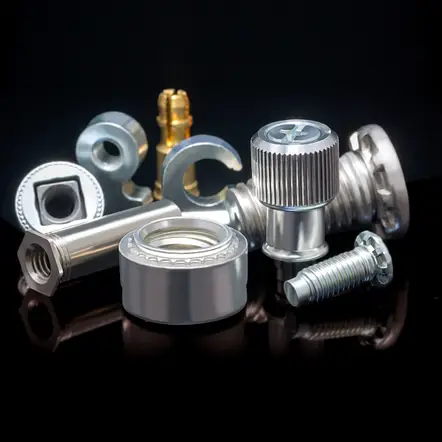Choosing the Right PEM Hardware: Types & Installation Best Practices
PEM hardware is an essential but often overlooked component of sheet metal fabrication. When traditional fasteners aren’t ideal, PEM hardware offers a highly effective alternative. A well-installed self-clinching fastener might never catch your attention, yet it plays a critical role in securing enclosures, panels, and components across industries.
We’ve installed millions of PEM fasteners. This guide will explore the most common types of PEM hardware and the key installation considerations to maximize performance.
What Is PEM Hardware?
PEM hardware, also known as self-clinching hardware, provides a permanent, threaded solution for thin sheet metal applications. These fasteners embed into the metal itself through a press-fit process, forming the basis for a high-strength hold.
PEM fasteners create reusable threaded connections in thin materials where traditional tapped holes aren’t feasible. Common in electronics, aerospace, medical devices, and enclosures, they also speed up assembly and improve accessibility.
PEM fasteners are available in stainless steel, plated steel, and aluminum, each offering different levels of corrosion resistance, conductivity, and strength. For example, pairing stainless steel PEM fasteners with aluminum sheet metal provides a stronger bond than aluminum-on-aluminum, improving both durability and performance.
Common Types of PEM Hardware and Their Applications
1. Self-Clinching Nuts
Self-clinching nuts are the preferred fastening solution for applications requiring a permanent, reusable thread in sheet metal as thin as 0.020 inches. Used in enclosures, panels, and industrial equipment, self-clinching nuts provide secure, vibration-resistant threading without affecting surface finish.
2. Self-Clinching Studs
Instead of using a screw, self-clinching studs offer a threaded attachment point directly on the metal surface. Used in hardware enclosures and control panels where multiple components need securing.
3. Self-Clinching Standoffs
Standoffs maintain precise spacing between components. This makes them particularly useful for mounting circuit boards and LED displays, where components must be kept at a specific distance for proper ventilation and electrical insulation.
4. Flush-Mount Fasteners
In applications where aesthetics and functionality go hand in hand, flush-mount fasteners provide a smooth, level surface while maintaining structural integrity. Used in medical devices, aerospace, and consumer electronics, where a clean, seamless finish is necessary.
5. Floating Fasteners
Floating fasteners allow slight movement during installation, helping compensate for misalignment in parts. These are particularly useful in telecommunications, industrial machinery, and complex mechanical assemblies where tolerance stacking is a concern.
Key Installation Considerations for PEM Fasteners
Even the highest-quality PEM hardware can fail prematurely if installed incorrectly. Following strict precision guidelines will keep every fastener performing as intended. Here are some key factors to consider:
1. Material Thickness & Hardness
PEM fasteners require sufficient sheet thickness to embed securely, and the metal must be softer than the fastener.
2. Proper Installation Equipment
Self-clinching fasteners require a controlled press installation, applying consistent pressure across the fastener to avoid damaging the surrounding material.
3. Accurate Hole Sizing & Placement
A precisely sized hole ensures a proper clinch — too small distorts material, and too large weakens the hold. HPM’s laser-cutting and CNC punching eliminate misalignment risks.
4. Surface Finish & Coatings
Plating, anodizing, or powder-coating sheet metal before PEM installation can interfere with the clinching process.
Why Choose HPM for Precision PEM Fastener Installation?
Our precision-driven fabrication process ensures every fastener is installed accurately for long-term performance. With advanced insertion technology and decades of expertise, we guarantee:
Automated Precision: High-accuracy fastener installation with modern programmable insertion equipment.
Material Compatibility Expertise: We help select the right PEM hardware for your specific application.
Integrated Solutions: We handle fabrication, finishing, and assembly to deliver a seamless end-to-end solution.
Get Expert Assistance for Your PEM Fastener Needs
Selecting the right PEM fastener is only half the equation — expert installation gives you long-term reliability. Our team takes the guesswork out of hardware selection and installation so your components are built to last. Need expert guidance on PEM fasteners? Contact us today to discuss your project.


